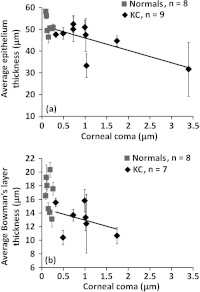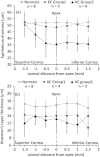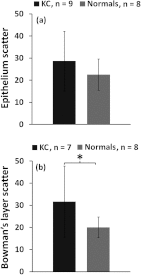Epithelium and Bowman's layer thickness and light scatter in keratoconic cornea evaluated using ultrahigh resolution optical coherence tomography
- PMID: 23117805
- PMCID: PMC3484266
- DOI: 10.1117/1.JBO.17.11.116010
Epithelium and Bowman's layer thickness and light scatter in keratoconic cornea evaluated using ultrahigh resolution optical coherence tomography
Abstract
A custom-developed ultrahigh resolution optical coherence tomography with an axial resolution of 1.1 μm in corneal tissue was used to characterize thickness and light scatter of the epithelium and Bowman's layer in keratoconic (KC) cornea noninvasively. A 4-mm wide vertical corneal section around the apex in nine KC and eight normal eyes was imaged in vivo. The epithelium and Bowman's layer were visualized and their thickness profiles were quantified. Scatter was quantified based on the sensitivity normalized mean signal intensity distribution. Average mean thickness of the epithelium and Bowman's layer in KC eyes was significantly smaller (p<0.05) than the normal eyes. The epithelium thickness variation across a central 3-mm cornea was significantly larger in KC eyes than in normal eyes. The scatter in KC eyes was significantly increased only for Bowman's layer. The changes observed in this study could improve our understanding of the underlying disease mechanism of KC and can provide new indications for early disease diagnosis.
Figures






References
-
- Hofstetter H., “A keratoscopic survey of 13,395 eyes,” Am. J. Optom. Acad. Optom. 36(1), 3–11 (1959).AJOAAX - PubMed
Publication types
MeSH terms
Grants and funding
LinkOut - more resources
Full Text Sources
Miscellaneous

